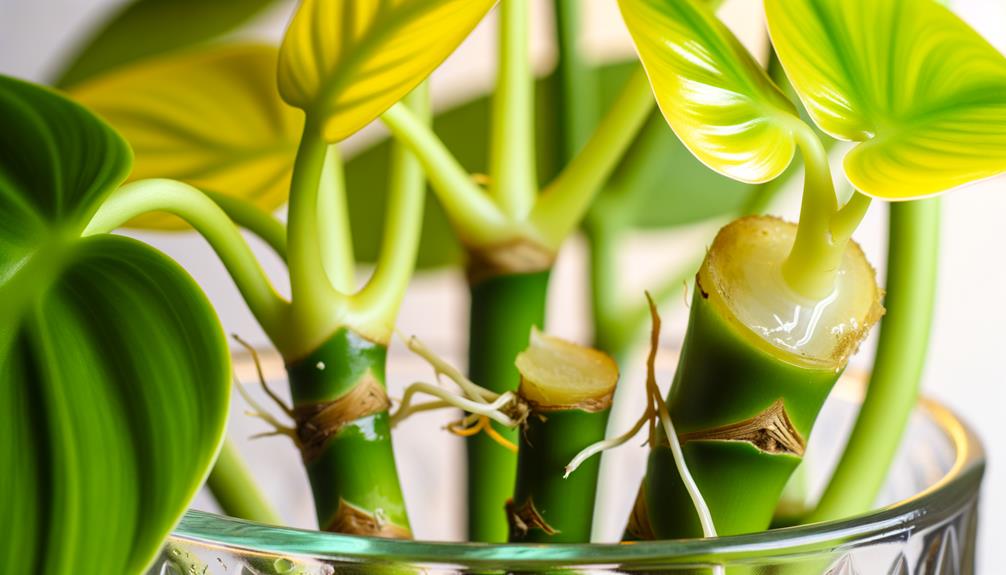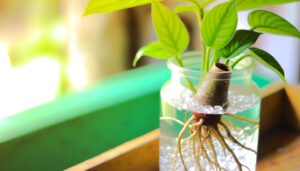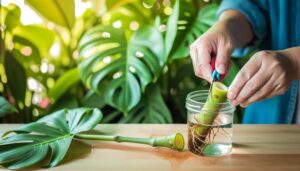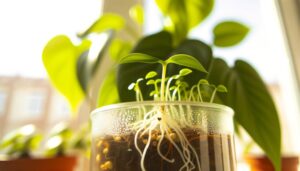Philodendron Ceylon Gold Propagation
To propagate Philodendron ‘Ceylon Gold,’ select 4-6 inch cuttings with 2-3 nodes from healthy, mature plants. Sterilize your tools in 70% isopropyl alcohol for 5 minutes, followed by rinsing with distilled water.
For water rooting, place the cut end in clear water, changing it frequently to support root development within 2-4 weeks. For soil rooting, use a well-draining organic potting mix in a pot with drainage holes.
Insert the cutting making sure at least one node is buried and maintain consistent moisture. Transplant to a suitable pot once roots form, continuing with appropriate care to guarantee vigorous growth.
Further knowledge awaits those intrigued by plant details.

Key Takeaways
- Select 4-6 inch healthy cuttings with 2-3 nodes from a mature Philodendron Ceylon Gold.
- Sterilize pruning tools with 70% isopropyl alcohol before making any cuts.
- Submerge cuttings in water or plant in well-draining soil with one node buried.
- Place cuttings in indirect sunlight and maintain consistent moisture for root development.
- Transplant rooted cuttings into a well-draining potting mix and monitor soil moisture levels.
Choosing Healthy Cuttings
To make certain successful propagation of Philodendron Ceylon Gold, it is crucial to select cuttings that exhibit robust health and strength. Begin by identifying stems that are free from pathogens, pests, and structural damage. Best cuttings should measure approximately 4-6 inches in length, containing at least two to three nodes.
Nodes are crucial as they are the sites for root development. Ensure that the leaves on these stems are vibrant, firm, and devoid of any chlorosis or necrosis. Additionally, prioritize cuttings from mature, well-established plants to maximize their regenerative potential.
Avoid using cuttings exhibiting signs of etiolation or mechanical stress, as these factors can compromise their viability during the rooting process and subsequent growth stages.
Preparing Your Tools
Securing the sterilization of pruning shears, scalpels, and rooting hormone containers is vital to prevent pathogen transmission and guarantee successful propagation.
Begin by immersing pruning implements in a 70% isopropyl alcohol solution for at least 5 minutes. This secures the eradication of microbial contaminants.
Following disinfection, rinse tools with distilled water to remove residual alcohol. Allow the instruments to air-dry on a sterile surface.
Additionally, if using powdered rooting hormone, sterilize the container by wiping it with an alcohol-soaked cloth, ensuring no residual pathogens persist.
Properly preparing your tools mitigates the introduction of diseases, enhances cutting viability, and optimizes the overall health of Philodendron Ceylon Gold cuttings.
Precision in these preparatory steps is essential for successful propagation.
Rooting in Water
After ensuring your tools are properly sterilized, the next step in propagating Philodendron Ceylon Gold is to prepare the cuttings for rooting in water.
Select a healthy stem, ideally with at least two nodes. Using a sterilized, sharp knife or pruning shears, make a clean cut just below a node. Remove any lower leaves to prevent submersion decay.
Submerge the cut end in a clear container filled with distilled or dechlorinated water, ensuring nodes are submerged but leaves remain above the waterline. Place the container in indirect sunlight, avoiding direct exposure.
Change the water every few days to prevent bacterial growth. Within 2-4 weeks, roots should begin to develop, preparing the cutting for subsequent transplantation.
Rooting in Soil
For effective soil propagation of Philodendron Ceylon Gold, select a well-draining potting mix enriched with organic matter to facilitate ideal root development. Use a pot with drainage holes to prevent waterlogging, which can lead to root rot. Insert the cutting into the soil, making sure at least one node is buried. Maintain consistent moisture without oversaturation and place the pot in indirect light. Temperature control is essential; maintain a range between 70-85°F to maximize root growth.
| Step | Action | Purpose |
|---|---|---|
| 1. Preparation | Select potting mix | Ensure proper drainage and nutrients |
| 2. Planting | Insert cutting | Promote node rooting |
| 3. Watering | Maintain moisture | Prevent root rot |
| 4. Placement | Indirect light exposure | Optimum growth environment |
Consistently monitor for root development, which typically takes a few weeks.
Transplanting New Plants
Transplanting new Philodendron Ceylon Gold plants requires careful preparation to achieve peak growth.
Begin by selecting an appropriate pot and preparing a well-draining soil mixture rich in organic matter.
Following transplantation, maintain consistent soil moisture and closely monitor the plants for signs of acclimation and new growth.
Prepping Soil and Pot
Selecting a well-draining potting mix and an appropriately sized container is crucial for the successful transplantation of Philodendron Ceylon Gold. The potting mix should be composed of peat moss, perlite, and pine bark to optimize aeration and drainage. The container should have drainage holes to prevent waterlogging, which can lead to root rot. A pot with a diameter of 2 inches larger than the root ball is recommended to provide space for growth without overwhelming the plant.
| Component | Description | Purpose |
|---|---|---|
| Peat Moss | Organic material | Retains moisture |
| Perlite | Volcanic glass | Enhances aeration and drainage |
| Pine Bark | Organic mulch | Improves soil structure |
| Container Size | 2 inches larger than root ball | Ensures sufficient growth space |
| Drainage Holes | Present in the container | Prevents waterlogging and root rot |
Watering New Transplants
Proper irrigation practices are crucial for the successful establishment of newly transplanted Philodendron Ceylon Gold, ensuring excellent root hydration without causing stress or overwatering.
Initiate watering immediately after transplanting to encourage soil settling around the roots. Employ a deep watering technique, saturating the soil to a depth of 6 inches, which promotes robust root development.
Utilize well-draining soil to prevent waterlogging, a common cause of root rot. Monitor soil moisture levels diligently; the top 2 inches should remain slightly moist but not waterlogged.
Frequency of watering should be adjusted based on ambient humidity and temperature, typically once every 7-10 days. Following these guidelines will promote healthy root establishment and ideal growth conditions for your Philodendron Ceylon Gold.
Monitoring Growth Progress
To maximize post-transplant growth of Philodendron Ceylon Gold, it is essential to systematically monitor the plant’s development through key growth indicators such as new leaf emergence, root expansion, and overall plant vigor.
Regularly inspect the foliage for signs of chlorosis or necrosis, indicative of nutrient deficiencies or water stress. Root health can be evaluated by gently probing the soil to check for white, firm roots, signifying active growth.
Employ a balanced, water-soluble fertilizer biweekly to support nutrient uptake. Additionally, maintain ideal humidity levels between 60-70% and ensure proper light conditions by providing indirect sunlight.
Document growth metrics weekly to identify trends and promptly address any deviations, thereby fostering robust plant development and ensuring transplant success.
Ongoing Care Tips
Proper ongoing care of Philodendron Ceylon Gold necessitates a thorough understanding of its watering and light requirements, precise pruning and shaping techniques, and effective pest and disease management strategies.
Ensuring ideal hydration and exposure to indirect sunlight promotes robust growth, while regular pruning aids in maintaining the plant’s desired form.
Vigilant monitoring for pests and diseases, coupled with timely interventions, is essential for sustaining plant health and vigor.
Watering and Light Requirements
Maintaining ideal growth for Philodendron Ceylon Gold involves keeping consistent moisture levels in the soil and providing sufficient indirect light. This species thrives in well-draining soil that retains some moisture but does not become waterlogged. Over-saturation can lead to root rot, a harmful condition for the plant. Monitor soil moisture with a hydrometer to ensure peak hydration.
For light requirements, Philodendron Ceylon Gold prefers bright, indirect sunlight to thrive. Direct sunlight may scorch the leaves, while inadequate light can impede growth.
Key care tips include:
- Watering Frequency: Water when the top inch of soil feels dry.
- Humidity: Maintain a humidity level of 60-70%.
- Light Intensity: Place in a location with filtered light.
- Monitoring: Regularly check for signs of over or under-watering.
Understanding these parameters will greatly improve the health and vigor of your Philodendron Ceylon Gold.
Pruning and Shaping Techniques
Effective pruning and shaping techniques are essential for maintaining the structural integrity and aesthetic appeal of Philodendron Ceylon Gold. Prune using sterilized, sharp pruning shears to prevent disease transmission. Target leggy growth, dead or yellowing leaves, and overly dense areas to allow better air circulation and light penetration. Make cuts just above a node or leaf joint to encourage bushier growth.
Regularly remove spent leaves and stems to direct the plant’s energy towards new growth. Shaping can be achieved by selectively pinching back growing tips, which promotes lateral branching. Conduct pruning during the plant’s active growing season, typically spring and summer, for best recovery and growth.
Employ consistent pruning schedules to maintain desired form and health.
Pest and Disease Management
Maintaining the health and aesthetics of Philodendron Ceylon Gold also involves diligent pest and disease management to prevent infestations and infections that can compromise plant well-being. Regular inspection and prompt intervention are key. Key pests include aphids, mealybugs, and spider mites, while diseases such as root rot and leaf spot can also affect the plant.
- Aphids and Mealybugs: Use insecticidal soap or neem oil for treatment.
- Spider Mites: Increase humidity and apply miticides if necessary.
- Root Rot: Ensure well-draining soil and avoid overwatering.
- Leaf Spot: Remove affected leaves and apply fungicides.
Consistent monitoring and early detection are essential for effective pest and disease control, guaranteeing robust growth and vibrant foliage.
Conclusion
Cultivating Philodendron ‘Ceylon Gold’ from cuttings mirrors the nurturing of a budding relationship between caretaker and plant. Following careful selection, tool preparation, and rooting methods in either water or soil, the shift to transplantation heralds new growth.
Sustained by continuous care, these lush companions flourish, transforming spaces with their golden foliage. This propagation journey, rooted in scientific accuracy, ultimately blossoms into a lush tribute to the harmony between horticultural expertise and nature’s resilience.






